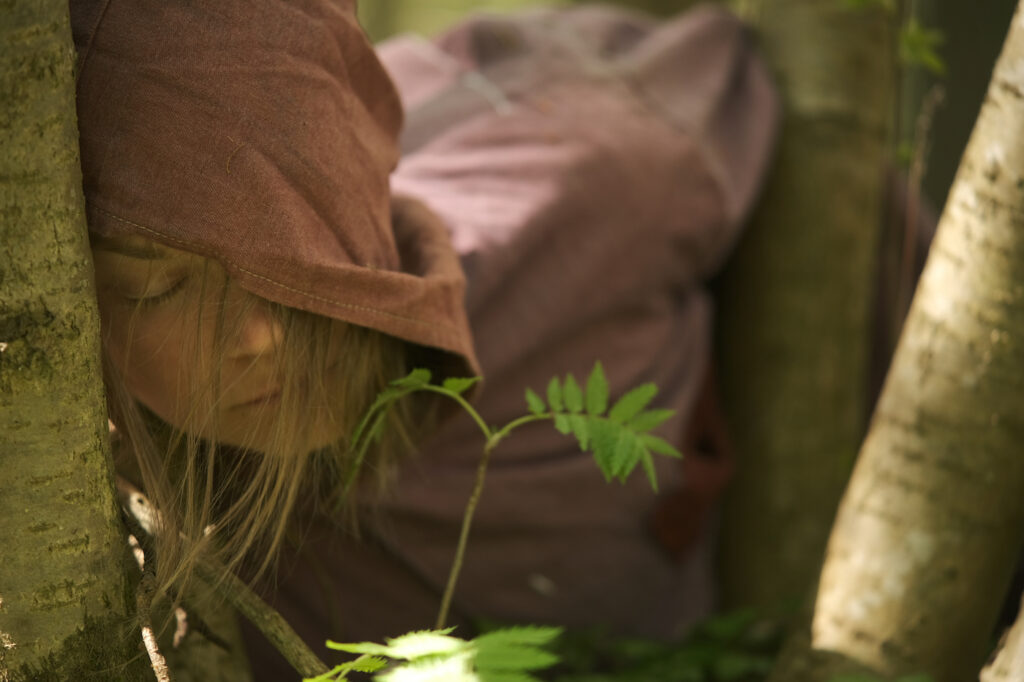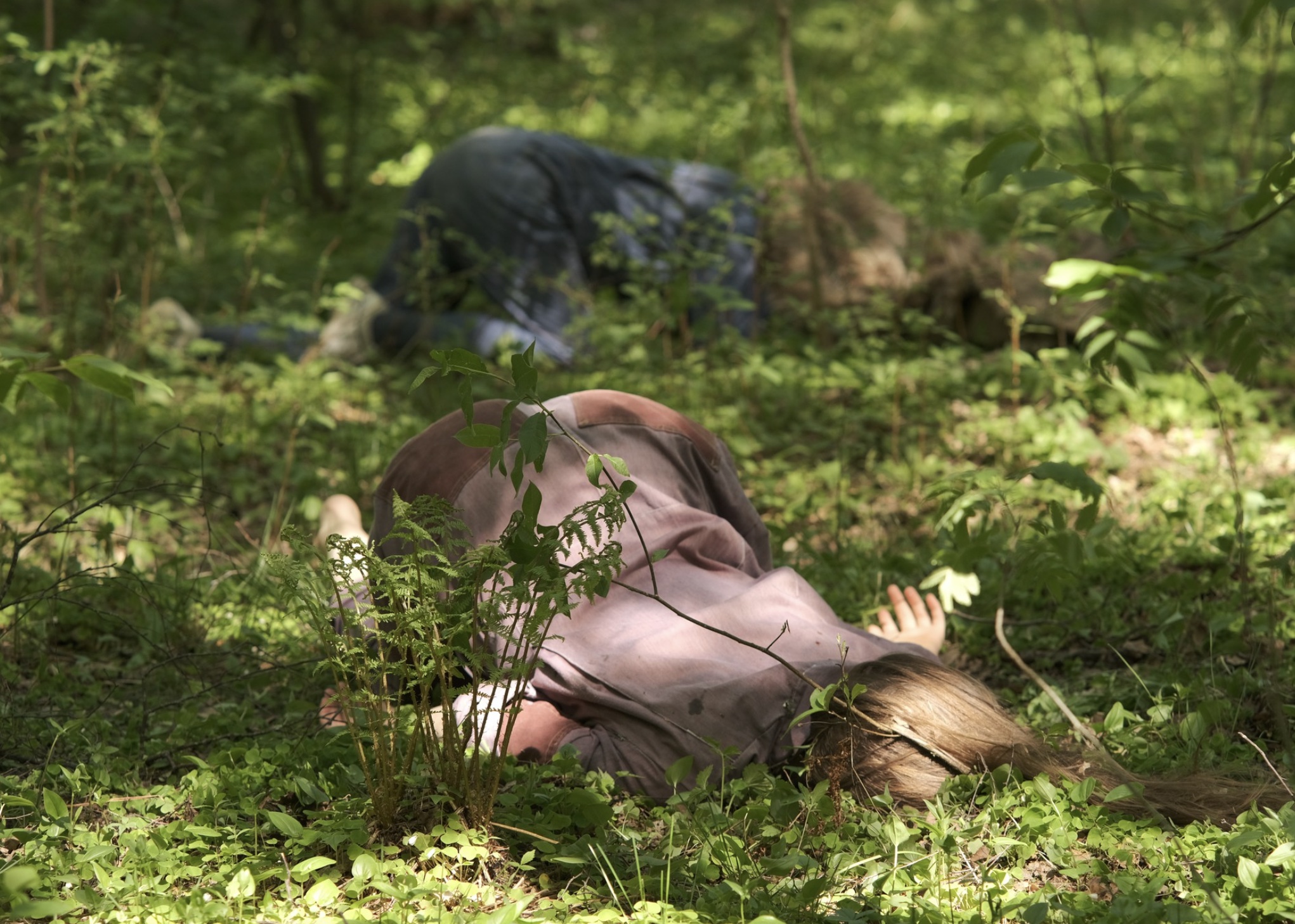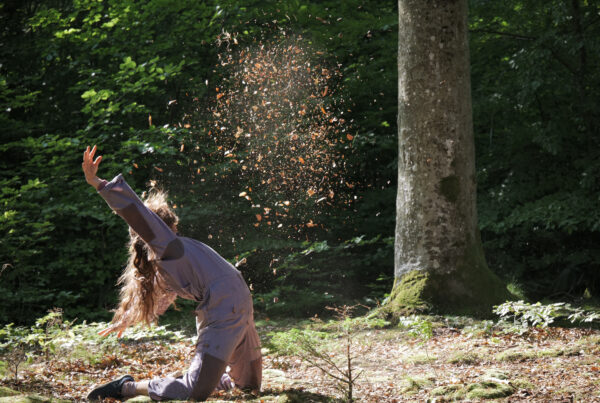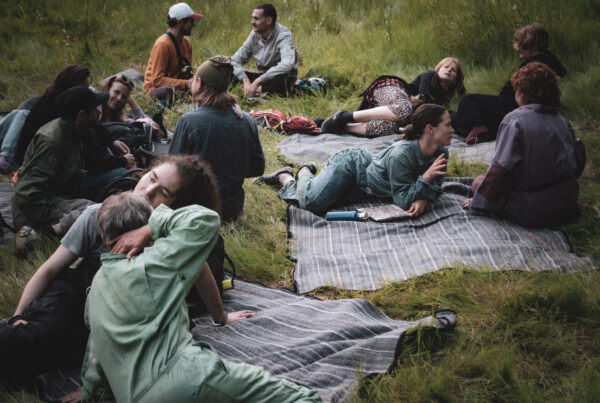19.05.23
Hanna Laura Kaljo
Olive closes her eyes, turns her gaze inward and lifts her right arm above her head. “I lived on a… the city is built around a harbour and I lived on a hill. It would often get very windy with cold wind coming from… up from Antarctica,” she recalls her childhood in Pōneke, also named Wellington, New Zealand. “And when it was windy and it was the weekend, I would go up to the top of the hill and,” both arms in the air now, “I would have music… I would have my Walkman on and I would dance in the wind and the rain… just like be in the motion… or allow myself to be moved by the environment”. I behold her as she sways like a child caught in a turbulent air current.
What does it mean to belong to movement? As a research question it continues to be alive in me, revealing new facets of itself when viewed from different disciplinary angles. Whether approached through the lens of developmental psychology, social anthropology or creativity, movement is at the foundation of who we are. When we speak about the climate crisis and how “it” is impacting our movement patterns as individuals, societies and ecosystems, we speak of rapid change and exponential loss. It’s as if the world we inhabit has sped up, is unravelling. Yet, “ironically,” writes philosopher and psychologist Bayo Akomolafe, “ ‘the Human’ is the weathering patterns we are with-nessing: ‘the Human’ is climate chaos”.
Instead of addressing this crisis as something happening “out there”, the former statement brings it home to ourselves. Yet home, too, has become a distributed notion, just as Akomolafe’s “the Human” is not so much an individual body as it is a systemic unfolding, an amalgamation of movement processes. This is where we meet, in the midst of it. “Looks like it’s going to rain,” I say, seeing dark clouds gather over my street in London as we begin our conversation. Olive Bieringa, a dancer and somatic movement therapist, is sat next to Joanna Kalm in Tallinn. The latter is also a dancer and an anthropologist. They’ve been out all day, rehearsing Resisting Extinction, due to be presented in the Merimetsa Nature Reserve at the end of May. Otto Ramstad, Olive’s partner and creative collaborator for over 25 years, joins us from their kitchen in Oslo. He is preparing dinner for their daughter, I can occasionally hear the food sizzle in the background.
Speaking about the weather has never been small talk in New Zealand, I learn. Even as “surrender” is how Olive chooses to describe what it felt like to grow up in the world’s windiest city, Resisting Extinction may well have its roots here. “Here” being the experience of a child finding her movement in the movement of air, in a city surrounded by water, shaped and contained by steep landforms. The concept of the performance, and its underlying practice, first came into view in 2017, in response to an enquiry both Olive and Otto were called to: what can dance makers and somatic movement therapists offer to a world seized by the winds of climate change?
The site-specific work consists of three parts: weather walks, the missing, and dying & decomposing practice. The first is a one-on-one performance journey that invites participants to move through a landscape and have a meaningful conversation about the climate crisis. “We are in an ongoing dance with the weather, of affecting and being affected,” reads the project description. A dancer and an audience member fall in and out of movement dialogue as they roam, relating to each other or failing to do so, exploring the affordances of their setting. Perhaps the conversation meanders through an early memory, perhaps a story of how the weather has impacted the communities from where they are from. Hopefully, conversing in this manner makes tangible the ways in which individual experiences are embedded within ecosystems. Or, perhaps more accurately, that ecosystems arise through the interplay of what is us and what is, seemingly, other than us.
To think humans ecologically has been the territory of philosophy and the relevance of dance has been recognised within its elaborations, but “they can’t see dance, they can’t be with dance, they can’t feel that…” Olive reflects. “The movement of the mind and…,” she lowers her interlaced hands, as if to push something from the air into the grounds, “the reality of the physical practice is very interesting.” They have to work together.
We are called to locate these movements of the mind within the lived experience of our body.
In other words, it’s about “sharing the inside of what it means to dance,” says Otto, also a somatic movement therapist in the Body-Mind Centering® tradition, developed by Bonnie Bainbridge Cohen.
Their definition of dance is expansive. “It’s movement and it’s art and it’s life,” Olive says. “Play and puzzling behaviour,” Otto adds. The crux of Resisting Extinction is to create the language by which we can share what it means to have movement experiences. Somatics as the field concerned with the human as perceived from within, by way of a first-person perspective, is a direct response to the lack of such a language. To speak from our bodily experience is important in fostering a “conscious embodiment culture”. Words are a creative force with which to build and demolish habitual ways of living.
When dance is life then “we can talk about embodiment as a kind of attending to, or maybe an awareness of, what it is to live inside a body. What is it to be in the experience of my physical, material being?” Olive explains. “So much of embodiment is actually relational and exists in this in-betweenness,” Joanna adds. “When I came into Somatics, I understood so much about what I was missing in dance,” she reflects. “Because dance is set in techniques or set in choreographies, but in Somatics I started to understand what is driving my movement and it became so much about the relationship to the outside, in terms of the senses. You know, simple thing, instead of just turning my head to turn my head, I’m turning my head to look somewhere.”
Devising the language, which communicates what it means to be embodied and have movement experiences, takes effort. “There’s a relatively robust discourse about the sensuality of different environmental conditions and how we talk about how we relate to our surroundings – but actual discussion or revealing of what it’s like to dance is very precious and mysterious,” Otto says. It’s about finding “the language to not only be individuals, but to be collectives or to be ecosystems or to be symbiotic beings… that we’re not an I but a We”.
Olive adds: “And yet our language is kind of reductive and problematic or unpractised. Our tongue doesn’t know how to give shape to these identities somehow. So there’s something about… practising it with the tongue also.”
“The smell of when the rain hits the ground and the concrete,” Otto reminisces. “I grew up in Minneapolis, in the city and… there’s an ozone smell often, because of the lightning that brings some of the ozone chemical down into the lower atmosphere. There’s just a lot of dynamic body-feeling of humidity and the heat and the building of pressure… I used to get headaches. The whole body is in the flow of this (weather)cycle.”
I notice that woven across our early memories is a dynamic between “danger” and “aliveness”. Be it the freedom Otto found moving outdoors in urban Minneapolis, US, even as the heat was difficult to bear for many, or the vitality Joanna felt running barefoot on gravel, in Muuga Aedlinn, Estonia, with bleeding toes.
The second part comprising Resisting Extinction is called the missing. In previous iterations, this is where the audience is informed of some of the endangered and extinct species in the place in which they have gathered. The invitation is to “wander, to spend time with what is seen, unseen, present and missing.”
Somatics is a direct response to what is missing in our culture. We conventionally think about extinction in relation to other species and environments, yet less so in relation to ways of being and moving as a human body.
Resisting Extinction also means recovering some of these ways. “We were designed to walk around on diverse surfaces and be in greater contact with different species,” Otto explains, referring to how modern life does not easily afford this. Even a loss of a way of moving may evoke grief.
Thus, the missing is concerned with the relational field. “How do I understand that the liquids that flow through me are connected to the liquids outside,” Joanna reflects. “Or that the air that I’m breathing is not just my air, it’s shared air. You start to think on these multiple levels. It’s as if this has become,” she places her right hand over her right shoulder, palm facing the wall behind her, “dormant knowledge.”
There is a term in Global Health research that speaks to why humans suffer when their respective environments are harmed. Coined by philosopher Glenn Albrecht, “Solastalgia” refers to “the distress that is produced by environmental change impacting people while they are directly connected to their home environment.” This is currently being researched through questions like: how do our rights to land and to healthy ecosystems connect to our own rights to health?; how and in which ways does mental health suffer when land is harmed?; can the land and body be recognised as an ecology?
Yet home has become a distributed notion. When anthropologist David Anderson undertook fieldwork among Evenki reindeer herders in Siberia and questioned his hosts about the location of their original clan land, he was told that in the past people travelled — and lived — not somewhere but everywhere. Olive: “As a first generation New Zealander, I grew up in this environment (whilst) my lineage is German, Jewish and Dutch.” “Displacement”, “(im)migration”, “exile” are the words that come to her mind in order to describe the movement experience of her ancestors. An aspect of her personal movement practice, therefore, has been about trying to understand what is “local” or what is “home”. As a result, the process of being in the world is functioning at a different scale.
If Somatics is a practice through which we find ourselves at home in our physical bodies, then how do we extend this place-making to our living environments, in order to feel at home in this world and widen our circle of concern? It is “memory, emotion and movement,” Stacy Holman Jones writes, “that work together to transform such spaces into affective places, creating imaginative mobilities through which we sense place and embody the territories of experiences.”
Similarly, anthropologist Tim Ingold wrote of a dwelling perspective as a way to “overcome the entrenched division between the two worlds of nature and society, and to re-embed human being and becoming within the continuum of the lifeworld.” Ingold’s contention is that lives are led “not inside places but through, around, to and from them, from and to places elsewhere.” He uses the term “wayfaring” to “describe the embodied experience of this perambulatory movement. It is as wayfarers, then, that human beings inhabit the earth.” What is more, where inhabitants meet, he writes, “trails are entwined, as the life of each becomes bound up with the other.” This may be what the weather walk too is tapping into.
“Somatics, if practised well, is already an ecological practice,” Olive says. She uses the word “Ecosomatics” simply as a tool to say “yeah, we’re going to practise this in the ocean, we’re going to extend the field of our attention to include this whole ecosystem and that’s the real deal.”

photo credits: Alissa Šnaider



